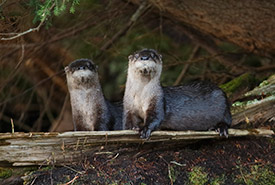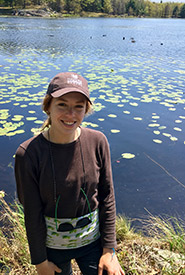An otterly delightful encounter

River otters (Photo by Dreamstime)
For as long as I can remember, I’ve been asked the question “what is your favourite animal?” As time passes, this question becomes increasingly more difficult for me to answer. How can I pick just one?
My favourite species changes like the seasons, and I often land on one that I’ve recently encountered. This has ranged from the red fox, as I watched her pups grow up on my commute to work, to the majestic barred owl that raised its young in the forest behind my house, to the gray ratsnake I saw climb up a tree as if it had arms and legs. And I can’t complete this list without mentioning every species of Ontario turtle I’ve helped cross the road. To me, any wildlife sighting is interesting, and the creatures I stumbled upon the first week of October during field work did not disappoint.
It was the turn of autumn, and I was visiting a property in the Frontenac Arch to document a new trail that led me through a forest of changing colours to an open water wetland. I love wetlands, and as I wandered the shoreline admiring the vista, I heard a grunt and a splash that caught my attention. By the time I looked up, the creature had submerged back into the pond. With my curiosity on overdrive, I quietly waited and watched, and to my surprise two smooth dark figures popped out of the water, lifting their snouts to the sky looking just as curious as I was. I slowly raised my binoculars to get a closer look and to my surprise, they were otters! Not just one, but two North American river otters.
Although elusive, North American river otters are widely distributed and found in a variety of aquatic habitats across the country. They are a member of the weasel family and have a long smooth, dark brown body, with whiskers that help detect prey when visibility is low, and valved ears and nostrils to keep the water out!
I’ve been lucky enough to encounter otters on a few occasions, and these sightings always make my day. As the weather cools, these mostly nocturnal (active at night) animals become more diurnal (active during the daytime) and are often described as playful, as they slip and slide through mud and snow, and swim long distances underwater hunting for their favourite food: fish! Their playful nature is important for their survival and teaches young otters skills like hunting and fighting.
My observation turned into a fascination, as I watched them a little longer. I then hiked on to finish my work with a renewed feeling of curiosity and an answer to the question I’ve been asked again and again…until the next wildlife encounter.
Want to support wildlife species and their habitat? With your donation, you are accelerating the pace of conservation and helping find solutions to the twin crises of rapid biodiversity decline and climate change. Learn more >


